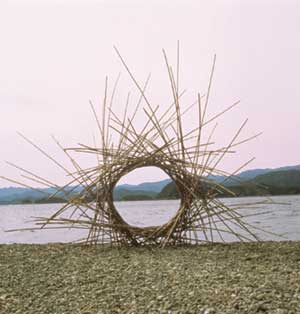Next stop on my Land Art tour is the fascinating world of the British sculptor and photographer Andy Goldsworthy. Goldsworthy is probably the most well known Land Art artist of today. He has also inspired a lot of informal and playful Land Art activity around the world.
In this blog post I will concentrate on a series of works that Goldsworthy created in Japan more than 25 years ago. One of the influences in Goldsworthy's work is Eastern philosophy with its emphasis on balance of opposites, as expressed in the ying-yang symbol. Much of his work incorporates the idea of balancing opposites until the tension results in collapse. These works in Japan, all created from bamboo sticks on a beach in Kiinagashima-cho in Autumn/Winter 1987, were part of a photo exhibition named Mountain and Coast. I'm not sure but I guess that these works, that are dated with the actual day they were created, incorporated the tide disintegrating the sculptures at the end of the day.
The sculptures and their setting on the beach with mountains in the background looks oddly familiar. It's almost as if it is the same location as in three of my other recent blog posts:
Sofu Teshigaharas drift wood sculptures from the mid 1960s,
Ryusaku Matsuda's bamboo works The Shape of Air ca. 2006, and
Kaïdin's drift wood sculpture on a beach from 2008.
In this blog post I will concentrate on a series of works that Goldsworthy created in Japan more than 25 years ago. One of the influences in Goldsworthy's work is Eastern philosophy with its emphasis on balance of opposites, as expressed in the ying-yang symbol. Much of his work incorporates the idea of balancing opposites until the tension results in collapse. These works in Japan, all created from bamboo sticks on a beach in Kiinagashima-cho in Autumn/Winter 1987, were part of a photo exhibition named Mountain and Coast. I'm not sure but I guess that these works, that are dated with the actual day they were created, incorporated the tide disintegrating the sculptures at the end of the day.
The sculptures and their setting on the beach with mountains in the background looks oddly familiar. It's almost as if it is the same location as in three of my other recent blog posts:
Sofu Teshigaharas drift wood sculptures from the mid 1960s,
Ryusaku Matsuda's bamboo works The Shape of Air ca. 2006, and
Kaïdin's drift wood sculpture on a beach from 2008.
In 1988 Goldsworthy took the sculptures from Kiingashima-cho a step further in a similar series of screens in the English Lake District. This time he placed the screens out in the water and made the reflexion on the water surface an important part of the work. The two last pictures are from that series.
 |
| Old Bamboo, Kiinagashima-cho, Japan, Nov. 27, 1987 |
 |
| Woven Bamboo, Kiinagashima-cho, Japan, Nov. 29, 1987 |
 |
| Bamboo spires calm to begin with wind becoming stronger, Kiinagashima-Cho, Japan, Dec. 4, 1987 |
 |
| Woven bamboo, windy..., Before the Mirror, Kiinagashima-cho, Japan, 1987 |
 | |
|
 |
| Screens series, Lake district, England, 1988 |